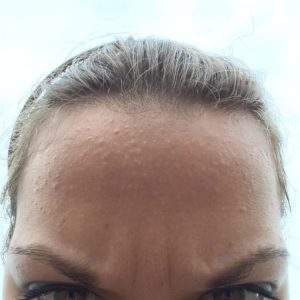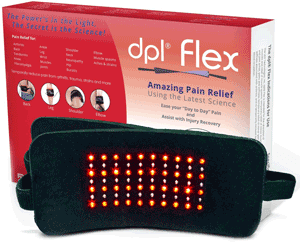When you examine the skin of your forehead or nose closely in the mirror, do you ever see those small, hard, white “grains”, sticking out of your pores?
Want to know what they are?

I did, because I too sometimes suffer from this mysterious condition. It’s hard to describe exactly what it looks like.
Essentially, at times, each pore appears to have what looks like a tiny, weeny grain of rice poking out of the opening.
Obviously it’s not actually rice, and generally these little grains are only a couple of millimetres long at most. And they’re not soft and squishy, they’re hard and cannot be squeezed.
If you run your fingernails across your forehead, do you end up with lots of fine, white “beads” under your nails? Like little white, pearly or yellow grains of sand?
And if you have a hot shower, does the combination of heat, steam and water leave your skin with a gooey, white gunk – mainly at the sides of your nose and between your eyebrows? (Note that if this “gunk” is oily and/or flaky and/or red, you might actually be dealing with seborrheic dermatitis which must be treated differently).
If you recognise any of this, do you know what causes these odd little skin grains?
Here’s three different reasons you might have them and what to do in each case.
By the way, you really should be having cold showers, especially if you have oily skin.
Hard sebum plugs
The first thing they can be is hard sebum.
If you have large pores, and let’s face it, most of us do, the air can get to the sebum inside the pore and dry it out so it forms a hard “plug”.
Then more sebum comes along underneath it, pushing this dry plug out of the pore opening until it’s sticking up out of your skin like a prairie dog and allowing it to dry out further, until it’s a hard globule of sebum.
The ideal solution is to rub a small amount of jojoba oil onto the congested area (just three or four drops on the end of your finger will suffice).
Jojoba oil is not in fact an oil at all. It is a wax which happens to be liquid at room temperature.
Jojoba oil is also very similar to sebum in terms of its molecular structure. The two waxy liquids are nearly identical, save for one chemical bond.
This means that jojoba oil can readily dissolve sebum, loosening any hardened sebum plugs which might be lurking in or on your skin.
As a bonus, because it so closely resembles actual sebum it’s also exceptionally good at keeping skin moisturized – which is the function of sebum, after all.
For more on the benefits of jojoba oil, read this post.
Keratin plugs
The second reason for these grains is the formation of keratin plugs.
Keratin is the sticky protein produced by some cells in your skin (called “keratinocytes”) which literally binds your skin cells together.
When you produce too much keratin (which is mainly controlled by your genetics dead skin cells which are naturally shed from the insides of your pores will become stuck together in clumps, clogging pores and leading to acne.
Keratin, like sebum, can dry on contact with air into hard particles, like grains of salt.
There is some scientific evidence to suggest that vitamin A plays a role in the regulation of keratin production, so vitamin A supplementation may help to reduce this condition.
Vitamin A is also the only supplement thought to help keratosis pilaris, another condition caused by the abnormal production and hardening of keratin.
Solgar is the only brand of vitamins I personally take and the only brand I ever recommend.
Vitamin A is a fat-soluble vitamin, meaning it requires dietary fat for it to be properly absorbed. Make sure you take vitamin A with a high-fat meal.
If the grains are covered by the top layer of skin, it’s probably milia
If you notice tiny, hard bumps on your face which look like miniature whiteheads, but which can’t be satisfactorily or productively “squeezed” like a normal whitehead, then you probably have milia. Milia are also called “milk spots” or “oil seeds”.
Milia occur when a hard lump of keratin forms inside the pore and never makes it to the surface, so the skin simply grows over it. Usually milia form near the eyes and nose.
Because they are small and relatively unnoticeable to anyone not inspecting your face from twelve inches away, if you only have a few milia I tend to think it’s worth waiting until they go away naturally.
While milia can be extracted by a professional, this may leave a scar. Eventually milia will disappear by themselves, although this can take up to six months.
Again, because vitamin A has been indicated to help regulate keratin, a vitamin A supplement may help to stop any more from forming.
A Few Additional Tips on How to Treat, and Prevent, Skin Plugs
If you’re absolutely tired of dealing with unsightly skin plugs, there are things that you can do about it, in addition to the tips that are mentioned above. The following strategies might even help you prevent skin plugs from forming in the first place.
First of all, you want to be sure that you’re keeping your skin clean so that you can prevent dead skin cells and oil from building up in your pores, clogging them up. Simply washing your face gently with mold soap and water can do the trick, but make sure you wash your face at least once in the morning and once before bed.
Next, certain topical treatments might help keep your pores clean and your skin clear. Look for products that you can use regularly, such as those with salicylic acid. There are also products that contain what are known as retinoids, which are derived from vitamin A. If these start to irritate your skin, though, it is best to avoid using them.
No matter what topical treatment you choose, make sure you purchase one that matches your skin type, whether it’s oily, combination, dry, or sensitive, and use it only as directed. Also, it is best to purchase treatments that are labeled as noncomedogenic, which means their ingredients will not block your pores.
On top of all of that, you can also try exfoliating your skin more regularly as well. This can help remove dead skin cells and clear your pores with ease. Just be sure to be gentle, as you do not want to end up irritating your skin and causing more harm than good.
To exfoliate correctly, you need to use warm water to thoroughly wet your face. Then, using an exfoliating scrub that you’ve made at home using natural ingredients, or one that you purchased in a store, gently clean the skin for up to a minute. Using the scrub in this manner will allow you to get into your pores to clean them out. Then, when you are all done, simply rinse your face off completely using warm water again. Pat your face dry with a soft towel to avoid any irritation.
When all else fails, talk to a dermatologist about how to get rid of embarrassing skin plugs that you can’t seem to get rid of on your own using various methods at home. Your doctor might prescribe stronger topical treatments, or you might be given oral medications that target skin problems from the inside. Just be sure to weigh the pros and cons of prescriptions, as they might carry the risk of side effects.
Note: if you try to remove a skin plug on your own, or if you pick at it incessantly, you might end up causing irritation, damage to the skin, scarring, or potentially even infection. Therefore, it’s best to avoid the temptation to pick at your skin; instead, use the right cleansing and exfoliating treatments to clear out your pores.
——————–
There you have it then, three reasons for those weird little grains you can scratch off your forehead (and what to do about them).
Mystery solved.


